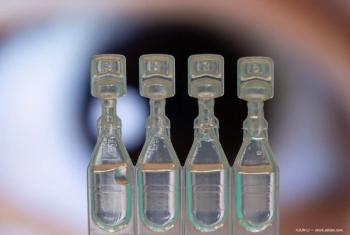
Researchers investigate how COVID-19 affects retinal microvascular structure
Key Takeaways
- COVID-19 infection may decrease retinal vascularity and perfusion, expanding the foveal avascular zone (FAZ) during the acute phase.
- Angiotensin-converting enzyme 2 (ACE2) receptors in the retina provide a pathway for SARS-CoV-2 entry, potentially affecting retinal anatomy.
This prospective case-control study included 85 patients with lung involvement related to the COVID-19 virus and a group of 50 healthy controls
A new study1 from Turkey reported that during the acute phase of the
The authors, led by Kazim Kiratli, MD, suggested that the anatomy of the retina might be affected over time along with the functional vision. Kiratli is from the Department of Infectious Diseases and Clinical Microbiology, Katip Celebi University Ataturk Educating and Research Hospital, Izmir, Turkey.
Kiratli and colleagues explained that angiotensin-converting enzyme 2 (ACE2) is expressed in most bodily tissues and is the site by which the SARS virus enters the cells.2 It is already known that the ACE2 receptors are located in the blood vessels, immune system, lungs, central nervous system, nose, cornea, conjunctive, and retina.3-5 In the last, ACE2 is in the vascular endothelium, ganglion cells, muller glia, and neurons in the inner nuclear layer,6 all of which provide a pathway for the virus.
This prospective case-control study included 85 patients with lung involvement related to the COVID-19 virus and a group of 50 healthy controls. Kiratli and colleagues measured the best-corrected visual acuity and intraocular pressure and evaluated the anterior and posterior segments in each participant. Optical coherence tomography angiography (OCTA) was performed in all participants; the choroidal and retinal changes were examined and recorded.
Measurement results
Compared with the healthy controls, the investigators did not find any significant changes in the choroidal thickness measurements in the COVID-19 group. Comparisons of the vascular densities and perfusion densities showed “a decrease in the averages of these values in the COVID-19 group, although [the differences were not] statistically significant (P=0.088, P=0.065 respectively). When the FAZ area values were compared, the average was 0.57±0.38 in the COVID-19 group, while it was 0.54±0.24 in the control group,” the authors reported.
Kiratli and colleagues pointed out that while significant differences in the measurements were not observed, the decreased vascularity and perfusion and the FAZ expansion occurred during the acute phase of the infection, ie, during the first month.
“These changes may anatomically alter the retina in the long term and affect the functional vision. Future ischemia-related alterations in the retina caused by a prior COVID-19 infection may arise in situations without comorbidities and may require concern in the patient’s systemic assessment.”
References
Kiratli K, Kahraman HG, Guven, YZ, Akay F, .Aysin M. COVID-19’s effects on microvascular structure in a healthy retina: an OCTA study. Int J Ophthalmol. 2025;2:283-289; doi:
10.18240/ijo.2025.02.12 Hoffmann M, Kleine-Weber H, Schroeder S, et al. SARS-CoV-2 cell entry depends on ACE2 and TMPRSS2 and is blocked by a clinically proven protease inhibitor. Cell. 2020;181:271-280.e8.
Hamming I, Timens W, Bulthuis ML, et al. Tissue distribution of ACE2 protein, the functional receptor for SARS coronavirus. A first step in understanding SARS pathogenesis. J Pathol. 2004;203:631-637.
Lange C, Wolf J, Auw-Haedrich C, et al. Expression of the COVID-19 receptor ACE2 in the human conjunctiva. J Med Virol. 2020;92:2081-2086.
Senanayake PD, Drazba J, Shadrach K, et al. Angiotensin II and its receptor subtypes in the human retina. Invest Ophthalmol Vis Sci. 2007;48:3301-3311.
Choudhary R, Kapoor MS, Singh A, et al. Therapeutic targets of renin-angiotensin system in ocular disorders. J Curr Ophthalmol. 2017;29:7-16.
Newsletter
Don’t miss out—get Ophthalmology Times updates on the latest clinical advancements and expert interviews, straight to your inbox.














































.png)


